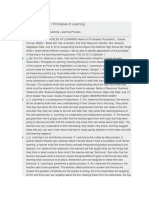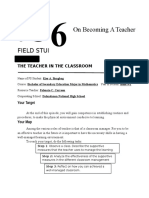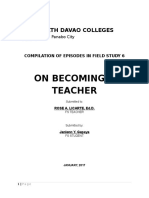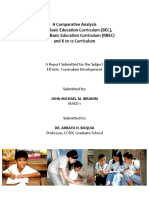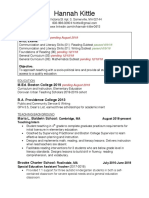Observation Reflection Paper
Observation Reflection Paper
Uploaded by
api-298858261Copyright:
Available Formats
Observation Reflection Paper
Observation Reflection Paper
Uploaded by
api-298858261Original Title
Copyright
Available Formats
Share this document
Did you find this document useful?
Is this content inappropriate?
Copyright:
Available Formats
Observation Reflection Paper
Observation Reflection Paper
Uploaded by
api-298858261Copyright:
Available Formats
Running head: OBSERVATION REFLECTION Stewart 1
Observation Reflection Paper
Maggie Stewart
University of Saint Mary
OBSERVATION REFLECTION
Stewart 2
Abstract
It is easy for someone to say they want to become a teacher, but I found in my case that I
did not realize how much I wanted to teach until I spent time in schools and classrooms
observing how schools truly run, what teacher-student relationships look like, and what
challenges teachers face every day. Not all people respect the teaching profession, and many do
not realize the time teachers must spend preparing and reflecting over every lesson. Students
today also present their own challenges to teachers; however, students are the reason for what
educators do, and the relationship between student and teacher needs to be one of respect,
compassion, understanding, and a true desire for the student to learn. I observed many different
methods of teaching, as well as different classroom climates, academic and multicultural
diversity, and other elements that I would have never thought of as being such an important part
of teaching.
OBSERVATION REFLECTION
Stewart 3
For my observations, I spent time at a private school setting, Xavier Catholic School in
Leavenworth, and an urban school setting, Anthony Elementary School in Leavenworth. I
enjoyed the time I spent at both schools, getting to know students and see how their teachers
went about teaching them. The differences in schools, teachers, and students helped me to better
understand the different types of schools and also to come to a better understanding of where I
would like to someday pursue my teaching career.
Xavier Catholic School is a kindergarten to eighth grade school, with only one class per
grade. The school consists of several different buildings, but all are fairly small. There are
Smartboards in all of the classrooms, but that is the only technology students have in the
classrooms. However, the school has two computer rooms that the students spend time in several
days a week if not every day. My urban school setting, Anthony Elementary School, is much
larger, with three or four grades per class and one large building. The classrooms that I observed
at Anthony have projectors and about six computers in the room for students to work on. Both
schools had about the same level of security: at the front door, visitors needed to ring the bell,
and the secretary would see the visitor through a camera and unlock the door. The visitor then
had to go through the office to sign in; at Anthony, however, this was done through a computer
with a camera that would take a photo of the visitor and print it on a badge for the visitor to wear.
As far as academic diversity, at Xavier I observed much more differentiated instruction
and hands-on activities in the younger grades than in the older grades; for example, the
kindergarten and first grade classes did several art projects while I was there, and the third grade
class put on a Thanksgiving play, for which they had created their own backdrops and props. In
the fifth grade class, on the other hand, I observed the teacher taught mostly through lecture,
presentation on the Smartboard, and individual work in their workbooks. While I understand that
OBSERVATION REFLECTION
Stewart 4
the information the students were learning will be on their standardized tests, I think there must
be a way to teach that information through lessons and activities that would reach all learners. At
Anthony Elementary, I only observed first grade classes, but in those classes I saw a good
amount of academic diversity, especially reading and math centers. The teachers gave the first
graders many different ways to explore the subject matter, and the students seemed very excited
to go to centers and do different projects. In both my observation settings, the teachers seemed
available to help students and give them one-on-one attention.
Student diversity includes many types of differences among students, such as ethnicity
and race, gender, religion, socioeconomic status, and home background. At Xavier, I observed
that there were only a few students of diverse races and ethnicities in each class, and several
students in the school who were English Language Learners. There seemed to be generally more
girls than boys. I am also not sure if any students were of different religions, since it is a Catholic
school and I would expect there to be both Catholic students and non-Catholic students whose
parents preferred in the environment of the school to a public school. I also do not know much
about the diversity of the students home backgrounds, but a benefit of attending such a small
school is that the teachers knew all their students and their families well and were thus able to be
aware of any problems. Anthony Elementary was more diverse in that there was an equal amount
of white and black students in the class I observed, but less diverse in that there were not more
races represented. However, in the other first grade class in which I spent only one day
observing, there were several students of Hispanic and Asian background. Both classes had more
boys than girls, and following the general rule for children of that age, the girls seemed shy and
reserved while the boys were outgoing and tended to be a bit rowdy. The teachers I observed at
Anthony also seemed to be very aware of their students diverse home lives and needs, and I
OBSERVATION REFLECTION
Stewart 5
even heard one teacher telling several of her students who had behavior problems in the past that
she was going to make home visits to inform their parents of how proud she was of their child
and how much the child had improved.
The classroom climate is what I observed the most differences in between the schools. At
Xavier, the whole school had a family-like climate since the teachers all knew each other well,
the students knew all their classmates well, and the teachers knew the students because they had
all of them in class, since generally the same group of students is in class together from
kindergarten to eighth grade. There seemed to be good classroom management with typically no
real behavior problems, which is a benefit of the close teacher-student relationships. One
negative thing I noticed about the class size and small amount of students in each grade is that a
child who did not fit in with his or her classmates would have difficulty finding other friends,
and it was easy for the rest of the students to bully him or her for a prolonged period of time. I
worry about the impacts this would have on a student who went through school for years without
friends and enduring bullying from classmates. The classroom climate at Anthony Elementary
was not what I would have expected at an urban school, probably because the teacher was
proactive about handling the behavior problems typical of urban schools and held her students to
high standards as soon as they entered first grade. Her classroom was extremely organized,
students were given responsibilities, and her style of classroom management was strict but ageappropriate; the students knew what behavior she expected from them and when they were
behaving in the wrong way, but her discipline of them was never emotionally harsh or insensitive
for the children. They knew that they would have to move their clip down on a chart if they were
not obeying, and that they could control moving their clip up and receiving a reward by their
good behavior and attentiveness to learning.
OBSERVATION REFLECTION
Stewart 6
The main similarities I observed between Xavier Catholic School and Anthony
Elementary School was that no matter what a teacher does, young students will behave at a
certain maturity level, and the teacher needs to be patient with them while still being firm and
holding them to high standards of behavior. The schools had different types of technology but
about the same amount; teachers were able to use technology to present to the class, and while
students did most of their work with pencil and paper or hands-on, they had exposure to and
opportunity to work on computers. In the younger grades at both schools, the teachers used a
good amount of diversity in presenting information in order to keep the childrens attention.
Also, all the classes I observed seemed to be a positive learning environment, managed very well
with little student disruption. The main difference I saw was the level of diversity among
students. The students from Anthony were more diverse in ethnicity and socioeconomic status, so
teachers needed to be aware of aspects of their students lives that could cause academic and
social challenges in the classroom. Xavier had a more close-knit environment, while Anthony
seemed much larger but also organized and maintained.
I loved getting to spend time with students in different school environments and better
understand the environments of varying schools. I think I would still prefer to teach at a Catholic
school because of the importance of faith in education and the overall feeling of close studentteacher relationships. However, the students at the urban school were wonderful kids, and I
would be happy to work with students who come from difficult home situations so that I could
use my gifts of patience and empathy and be a positive influence in their lives. Overall, I learned
an invaluable amount from spending time in real schools, seeing the challenges and joys of being
an educator.
You might also like
- Strategic Directions BEDP PillarsDocument48 pagesStrategic Directions BEDP PillarsDENNIS BERMOY100% (2)
- SPED Observation AssignmentDocument14 pagesSPED Observation Assignmentbobbymaf750% (2)
- Field Observation EssayDocument2 pagesField Observation Essayapi-550548834No ratings yet
- My Own Educational PhilosophyDocument2 pagesMy Own Educational PhilosophyElia Kim FababeirNo ratings yet
- TSL 3109 - Classroom Observation ReportDocument6 pagesTSL 3109 - Classroom Observation ReportAttenuator James100% (1)
- FS1 Episode 1Document6 pagesFS1 Episode 1Zaira Shaine Buyan100% (1)
- Reflective JournalDocument3 pagesReflective JournalElizabeth BailsNo ratings yet
- Field Study 2-MaryjaneDocument4 pagesField Study 2-MaryjaneLeoFe Diez LagudNo ratings yet
- Group 10 (ASL 2)Document49 pagesGroup 10 (ASL 2)Ivy Marie MaratasNo ratings yet
- fs2 - Episode 1Document4 pagesfs2 - Episode 1Erizza Mae PagosoNo ratings yet
- Student Teaching Journal Leah MichajlukDocument17 pagesStudent Teaching Journal Leah Michajlukapi-293358997No ratings yet
- Student Teaching ReflectionDocument1 pageStudent Teaching Reflectionapi-348361949No ratings yet
- Why I Am Ready To Become A TeacherDocument5 pagesWhy I Am Ready To Become A Teacherapi-259262734No ratings yet
- Field Study 6 - Episode 2Document7 pagesField Study 6 - Episode 2Anonymous ZcIiVjdTkNo ratings yet
- Fs 2Document15 pagesFs 2Rosechel Regaspi RosendoNo ratings yet
- Field Study 1 FilesDocument42 pagesField Study 1 FilesMischelle 'mitch' Perez100% (1)
- Episode 13 Utilizing Application For Teaching and LearningDocument14 pagesEpisode 13 Utilizing Application For Teaching and LearningPagarigan, Roxanne kaye B.No ratings yet
- The Learner'S Development and EnvironmentDocument13 pagesThe Learner'S Development and EnvironmentIvy RasonableNo ratings yet
- My Philosophy On EducationDocument3 pagesMy Philosophy On Educationapi-236602178100% (1)
- Field Study 1 Episode 4Document4 pagesField Study 1 Episode 4Marie Anjellyn AdolfoNo ratings yet
- Phases of Student TeachingDocument6 pagesPhases of Student TeachingJehndel F. Roquero100% (1)
- Classroom and Behavior Management Reflection PaperDocument7 pagesClassroom and Behavior Management Reflection Paperapi-393166152No ratings yet
- Practice Teaching PortfolioDocument69 pagesPractice Teaching PortfolioBenj Jamieson Jocson DuagNo ratings yet
- Fs3 AnswersDocument27 pagesFs3 AnswersAzeneth GarciaNo ratings yet
- Educational PhilosophyDocument5 pagesEducational Philosophyapi-340084081No ratings yet
- en Improving Students Writing Skill Using ADocument15 pagesen Improving Students Writing Skill Using AfatinfiqahNo ratings yet
- Episode 3 FS1Document15 pagesEpisode 3 FS1Mary Jane LubricoNo ratings yet
- Documents - Tips Field Study 2 Fs2 Experiencing The Teaching Learning ProcessDocument55 pagesDocuments - Tips Field Study 2 Fs2 Experiencing The Teaching Learning ProcessAra Mae P. LizondraNo ratings yet
- Bago Episode 1Document9 pagesBago Episode 1michelle diazNo ratings yet
- Fs 2Document7 pagesFs 2api-309997842100% (1)
- Observe, Analyze, ReflectDocument16 pagesObserve, Analyze, ReflectMark Warren Atienza RevellameNo ratings yet
- Classroom Management PlanDocument16 pagesClassroom Management PlanLara LandryNo ratings yet
- On Becoming A Teacher: North Davao CollegesDocument23 pagesOn Becoming A Teacher: North Davao CollegesJanlenn GepayaNo ratings yet
- Internship ReflectionDocument3 pagesInternship ReflectiontheoNo ratings yet
- Elm 375 Formal Observation ReflectionDocument2 pagesElm 375 Formal Observation Reflectionapi-383419736No ratings yet
- Teachers PrayerDocument1 pageTeachers PrayerFrance Jackson Cariaga TadejaNo ratings yet
- Meaning o F CurriculumDocument3 pagesMeaning o F Curriculumcherry adolfoNo ratings yet
- My Personal Philosophy of EducationDocument7 pagesMy Personal Philosophy of Educationapi-250901151100% (1)
- Teaching ProfessionDocument30 pagesTeaching ProfessionMary Ann GabionNo ratings yet
- Fs 2 Experiencing The Teaching-Learning ProcessDocument29 pagesFs 2 Experiencing The Teaching-Learning Processkakatuwa71% (7)
- Student Teaching Final ReflectionDocument7 pagesStudent Teaching Final Reflectionapi-267622066No ratings yet
- Episode 3 - Classroom Management and LearningDocument10 pagesEpisode 3 - Classroom Management and LearningOmar Lizada MendozaNo ratings yet
- Reflection PaperFTC103Document2 pagesReflection PaperFTC103JCNo ratings yet
- 17 Conducve Learning EnvironmentDocument101 pages17 Conducve Learning EnvironmentZul Aiman Abd WahabNo ratings yet
- Learning EpisodeDocument85 pagesLearning EpisodeFerliza Cudiamat Pacion63% (8)
- Board Display Field StudyDocument6 pagesBoard Display Field StudySelang PastNo ratings yet
- TPI Teaching PortfolioDocument20 pagesTPI Teaching PortfolioKeiry AriasNo ratings yet
- Field StudyDocument36 pagesField StudyJohn Van Dave Taturo25% (4)
- FS 1Document28 pagesFS 1almari_1140550% (2)
- In Partial Fulfillment in FS 2 Portfolio Kim Kim KimDocument8 pagesIn Partial Fulfillment in FS 2 Portfolio Kim Kim KimJedidiah Daniel Lopez HerbillaNo ratings yet
- Artifact 4 - Classroom ObservationDocument3 pagesArtifact 4 - Classroom Observationapi-399672613No ratings yet
- Self-Evaluation of A Lesson Plan Taught: Virginia Teachers For TomorrowDocument2 pagesSelf-Evaluation of A Lesson Plan Taught: Virginia Teachers For Tomorrowapi-314646235No ratings yet
- My Teaching PhilosophyDocument2 pagesMy Teaching Philosophyapi-499241405No ratings yet
- Field Study 2-Participation & Teaching Assistantship Module 3 (Educ 113)Document3 pagesField Study 2-Participation & Teaching Assistantship Module 3 (Educ 113)RIAMAY APIADONo ratings yet
- Fs 1 Complete PDF FreeDocument45 pagesFs 1 Complete PDF Freeevangeline bayronNo ratings yet
- Classroom EnvironmentDocument26 pagesClassroom EnvironmentMc Cruzt KristoferNo ratings yet
- Observation ReflectionDocument2 pagesObservation Reflectionapi-265684105No ratings yet
- My Teacher is My Hero: Tributes to the People Who Gave Us Knowledge, Motivation, and WisdonFrom EverandMy Teacher is My Hero: Tributes to the People Who Gave Us Knowledge, Motivation, and WisdonNo ratings yet
- 2Document13 pages2Jasmina MilojevicNo ratings yet
- Edl 318 Paper 4-9-2015Document9 pagesEdl 318 Paper 4-9-2015api-285668067No ratings yet
- Learning Episode 4Document6 pagesLearning Episode 4Jemmuel SarmientoNo ratings yet
- Philosophy of Education Final DraftDocument5 pagesPhilosophy of Education Final Draftapi-298858261No ratings yet
- Running Head: Purposeful Questions AnalysisDocument4 pagesRunning Head: Purposeful Questions Analysisapi-298858261No ratings yet
- Aristotle and Augustine On Friendship Honors ProjectDocument10 pagesAristotle and Augustine On Friendship Honors Projectapi-298858261No ratings yet
- Culture Bag PaperDocument8 pagesCulture Bag Paperapi-298858261No ratings yet
- Schema Theory and EducationDocument7 pagesSchema Theory and Educationapi-298858261No ratings yet
- Shaun - Research Essay FinalDocument13 pagesShaun - Research Essay Finalapi-613860804No ratings yet
- Proposed Standards in History and Geography EducationDocument8 pagesProposed Standards in History and Geography EducationFroilan CelestialNo ratings yet
- Abra State Institute of Sciences and Technology Graduate SchoolDocument4 pagesAbra State Institute of Sciences and Technology Graduate SchoolSheenley PardoNo ratings yet
- Prof ED W AnswersDocument9 pagesProf ED W AnswersJane Magsombol Pujante LptNo ratings yet
- FS 4 - 5Document92 pagesFS 4 - 5Jamie HaravataNo ratings yet
- Activity Report For Vocational Education: Computer Science (HKBK College of Engineering)Document31 pagesActivity Report For Vocational Education: Computer Science (HKBK College of Engineering)soory192004No ratings yet
- Project 3 Generations: 1. Timetable and Deadlines For The Different PhasesDocument27 pagesProject 3 Generations: 1. Timetable and Deadlines For The Different PhasesrainyzzzzNo ratings yet
- New TIP Course 1 DepEd Teacher 1Document89 pagesNew TIP Course 1 DepEd Teacher 1Spyk SialanaNo ratings yet
- Statement of PurposeDocument1 pageStatement of PurposeAndrei DiazNo ratings yet
- Socs 42 Comparative Economic Planning 1Document12 pagesSocs 42 Comparative Economic Planning 1angelicajane.cortezNo ratings yet
- 21 Century Challenge: Arranged By: 1. Indi Rizki Ausa 2. Maulida Nur Fauziyah 3. Ninik KrisnamurtiDocument12 pages21 Century Challenge: Arranged By: 1. Indi Rizki Ausa 2. Maulida Nur Fauziyah 3. Ninik KrisnamurtiFeby LestariNo ratings yet
- Mirror On Macintyre 2018Document14 pagesMirror On Macintyre 2018Carla BeattieNo ratings yet
- NENGOMASHA EMILY Curriculum VitaeDocument11 pagesNENGOMASHA EMILY Curriculum Vitaeemily nengomashaNo ratings yet
- Boarding School 101Document10 pagesBoarding School 101Siifyoom HarmeeNo ratings yet
- CONFLICTED ATTITUDES - Yamasaki (2010)Document23 pagesCONFLICTED ATTITUDES - Yamasaki (2010)SofiaNo ratings yet
- Resume Agrawal 2018Document1 pageResume Agrawal 2018api-401763765No ratings yet
- Comparison of K 12 and Bec CurriculumDocument21 pagesComparison of K 12 and Bec CurriculumApple Silvestre Miranda100% (2)
- New Teacher Orientation BookletDocument24 pagesNew Teacher Orientation BookletwagnergarrenNo ratings yet
- 1329 5201 1 PBDocument14 pages1329 5201 1 PBAidana TynyshtykNo ratings yet
- Data Base ACLG Project - As On 20 TH June'22Document11 pagesData Base ACLG Project - As On 20 TH June'22dhruvapocof1No ratings yet
- Education in Bangladesh: Changing Contexts and Emerging RealitiesDocument19 pagesEducation in Bangladesh: Changing Contexts and Emerging RealitiesShahriar SayeedNo ratings yet
- Aguti Hellen Margaret - Research Report Stafford University - Sept 2019Document94 pagesAguti Hellen Margaret - Research Report Stafford University - Sept 2019ComNet Computer ServicesNo ratings yet
- Cca Act - 0Document2 pagesCca Act - 0Toon WonderNo ratings yet
- A Closer Look On The Education System of Selected Countries SynthesisDocument2 pagesA Closer Look On The Education System of Selected Countries SynthesisJay GenonNo ratings yet
- Educ 5 - Activity 2Document3 pagesEduc 5 - Activity 2Jr Castrodes60% (5)
- LECTURE NOTE q2 UCSP With ActivitiesDocument29 pagesLECTURE NOTE q2 UCSP With ActivitiesRose Andrea BatoonNo ratings yet
- SP EdDocument2 pagesSP EdDaniela Jean BaileNo ratings yet
- Appendix A (Curriculum Vitae)Document21 pagesAppendix A (Curriculum Vitae)lenovo amadoraNo ratings yet
- Hannahkittleresume 01Document3 pagesHannahkittleresume 01api-432271368No ratings yet














